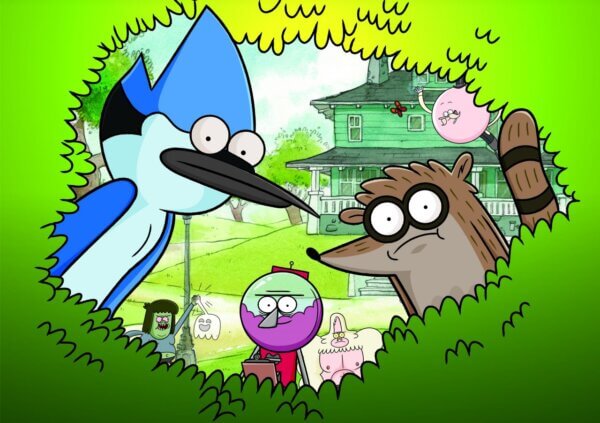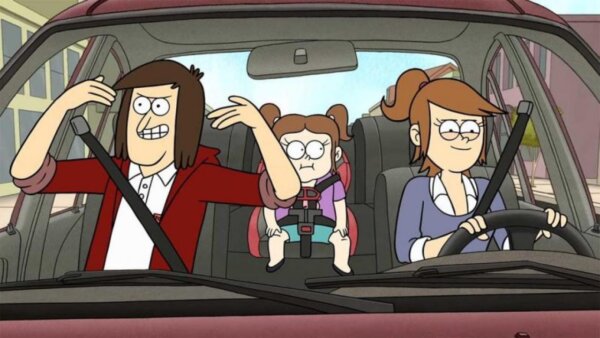10th Anniversary of Regular Show: How a Modern Classic TV Series Was Conceived
Regular Show, for those unfamiliar with the Cartoon Network Studios series, stars Mordecai the blue jay and Rigby the titular raccoon, two irresponsible and immature best friends who live and work in a park. But their mandatory days usually end up in crazy shenanigans that become unexpectedly out of control as they find themselves having to arm wrestle with Death for their souls, battle agents over laser discs and even having galactic adventures, all while dealing with the everyday problems of young adulthood.
The series celebrates its tenth anniversary this month since the first episode, titled The Power, broadcast on the Cartoon Network channel. But throughout the past decade, it has become one of the most comedically bizarre animated shows on the channel and gained fans all over the world.
As one of those many fans, I want to celebrate this animated show and the talented individuals responsible for bringing the wacky band of characters and their hilarious antics to life.
But how did the show’s creator, J. G. Quintel, start in the animation industry? And how did he eventual create Regular Show?
Quintel studied at the world renowned American university CalArts where he specifically studied character animation after making short films throughout high school for classroom assignments. In 2005, he won the Producers Choice and Student Award at the second Nicktoons Network Animation Festival for his short film The Naïve Man from Lolliland before he returned to the festival the following year as a judge and a graduate from CalArts.
After his graduation, he found himself working at Cartoon Network as a storyboard artist and writer on Camp Lazlo, a show featuring eccentric anthropomorphic animals at a rundown summer camp. This was an extremely fitting show for Quintel as he was a fan of Camp Lazlo’s creator Joe Murray’s previous show, Nickelodeon’s Rocko’s Modern Life. He continued to work at Cartoon Network, moving on to work on The Marvellous Misadventures of Flapjack in 2008 as a creative director.
At roughly the same time, the channel started a program called Cartoonstitute where employees could pitch new ideas to Rob Renzetti (creator of My Life as a Teenage Robot) and Craig McCracken (creator of The Powerpuff Girls and Foster’s Home for Imaginary Friends) to develop new potential shows. Looking back at the characters he developed over the years in his short films from CalArts (including the previously mentioned The Naïve Man from Lolliland), he put together a concept for a show and was one of the select few creatives given the greenlight to produce a pilot. The Regular Show pilot premiered in 2009 and was successful enough to be given the go ahead for a first season the following year.
As well as the creator himself, many talented and creative individuals all made huge contributions to make this series one of the best surreal animated comedies to ever be produced throughout the past few years not just for Cartoon Network, but in the television industry as a whole. And some of his ideas proved to be very beneficial to the outcome of the production with the team’s support.
These ideas included inviting some comic book artists as crew members on the show to help it’s distinct and cartoonish style and use more traditional approaches to the animation with paper and pencil rather than using graphic tablets like Cintiq. J. G. Quintel looked at some of the work being produced by independent comic book artists and since Regular Show was driven by storyboards, he was looking for new talent who could draw the storyboards and write the dialogue that would go with it. As a lot of comic book artists he was looking at wrote their dialogue as well as drawing their own images, he ended up hiring such people as Calvin Wong and Hellen Jo based on their work on independent comic books like Ramble On! And Frontier. This also played a key component when using the more traditional approach that he wanted to use as these comic book artists were already used to using similar tools that the other animators used like electric erasers and light boxes.
From the series writers and directors like Michele Cavin and Sean Szeles to the producers like Jennifer Pelphrey and Brian A. Miller, these few of many creative individuals were part of a diverse range of talented people who made it possible to make Regular Show what it was. They would give the same dedication to other creators at Cartoon Network to bring their titles to life, including Craig of the Creek, Steven Universe and Apple and Onion, But more than that, they supported Quintel’s unique ideas and approaches when it came to brining the characters and this bizarre world to life.
Regular Show has achieved so much within the past ten years since the first episodes premiered. It ran for a total of eight seasons that were made up of over two hundred and fifty episodes when it concluded in 2017; it won a Primetime Emmy in 2012 for Outstanding Short-format Animated Program; it had a feature film in 2015; and it even had its own comic book series developed by the renowned Boom! Studios.
But J. G. Quintel did use the creativity and success he developed on the show to create a successor after it’s finale wrapped up in the form of a new series named Close Enough. Fans were excited at seeing his latest series, especially as it looked like it was made for a mature audience, but the show was shelved for three years despite the positive reception of the initial trailer when it dropped online in 2017. The wait was long, but Close Enough eventually remerged on HBO Max in July in the United States and the series is now available to watch on Netflix in the UK and other international territories. There may be no anthropomorphic blue jays or raccoons in sight, but the show still holds up to the quirky and zany humour and art style that fans and newcomers to Quintel’s work will enjoy.
While ten years may not seem like such a long time to create a series of accomplishments, everyone who was or continues to work at Cartoon Network that played a part in Regular Show’s production should be proud to have created one of the funniest and obscure titles to have graced the silver screen throughout the past decade.
Learn more about the origins of Regular Show in our 2014 interview with creator J.G. Quintel



